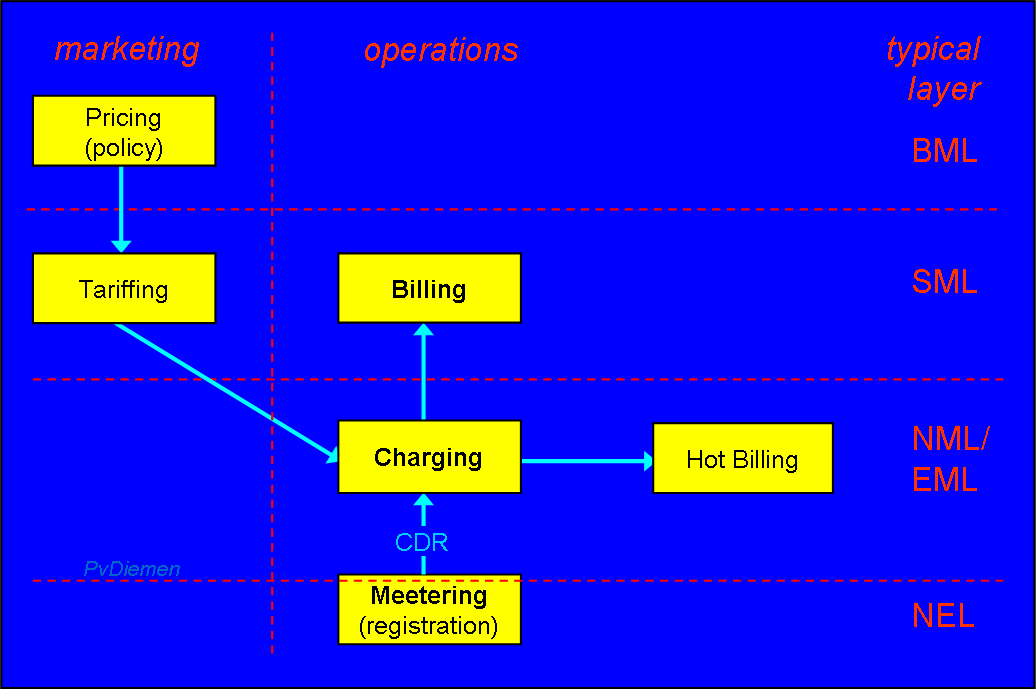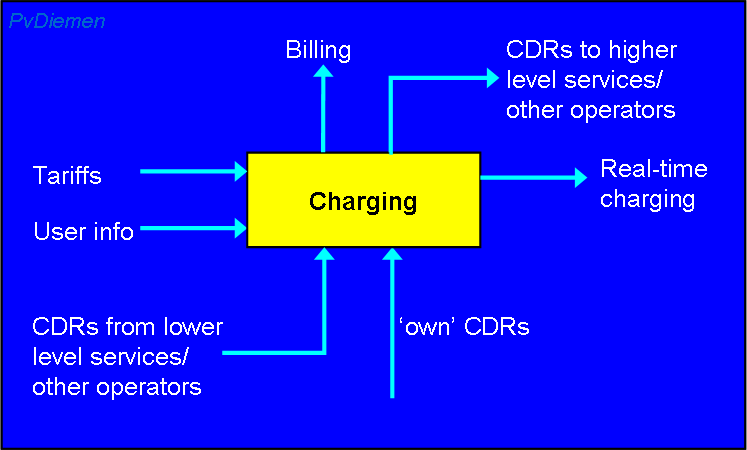
3 Management Functional Areas
Last update
PvD
3.4 AM
Accounting Management
Overview
[M.3400]: Accounting Management (AM) provides a set of functions which enable the use of the network service to be measured and the costs for such use to be determined. It provides facilities to:
In short, Accounting Management facilitates billing the user. This may seem just one of the potentially many measurements in the system, it is the only way for the network operator to receive money for services rendered ! Without billing a network will not enter commercial operation.
Billing is based on a tariff for service usage. As not all service usages are identical (voice calls are not the all same), they are characterised by some attributes (e.g. volume, duration, distance and/or destination, etc.).
The tariff defines a price for these attributes, and is set in advance by the service operator.
If the service usage is dynamic (e.g. switched services, not a leased line), measurements have to be implemented in the NE. These measurements are aggregated to allow charging (notice of cost) for that service instance.
Periodically, charging records are collected and sent to the customer for billing (i.e. including invoicing).
For some services, billing has to be provided in real-time (real-time charging: 'hot billing', e.g. for pre-paid cards, coin boxes, other service providers).
The following provides an overview and the relationships between above mentioned concepts:

Billing is also often subject of disagreement with users. Therefore, meetering, charging and billing require special attention with respect to:
Remark: There is a considerable overlap between Performance Management and Accounting Management, in particular regarding the collected data: both collect usage and performance data on individual users. The main difference is in the goals to be achieved: AM must provide a bill and PM must report(/control) quality. When PM shows poor service for a customer, he may get a refund (i.e. potentially billing consequences).
Meetering is the registration of usage (counters) of resources.
Preferably billing is based on costs (most fair and avoids exploitation of loopholes). A strict cost-based mode of operation would imply that all resource usage by each service instance must be meetered.
This is in general highly impractical (huge amount of data, a great many tariffs).
One can also restrict himself to meetering of 'expensive' resources, or resources which are considered to represent the overall usage.
This approach can also avoid undeterministic behaviour of service cost (e.g. when a call is using an overflow route due to congestion).
There is obviously an interaction between meetered resources and tariffs.
The result of meetering (i.e. usage data) is commonly called a Call Detail Record (CDR). For some services (notably voice) there is a de-facto standard for CDRs.
CDRs can also used for other purposes; one might attach QoS results, or at least indicate the reason for call release/failure.
For some static services (e.g. Leased Lines) meetering is virtually non-existent; charging/billing is then a pure administrative operation (in Network Management) without usage data from NEs.
In some networks –notably mobile networks– a separate organisation is used as 'clearing house': they get all data regarding 'roaming' calls and settle the cost between 'guest' and 'home' operators.
Charging is the aggregation of all CDRs for a single service instance to a single record and assigning cost units to it ('rating').
Aggregation is potentially from various NEs, potentially from other operators (i.e. multi-domain services, e.g. international), and potentially for lower level services (i.e. multi-layered services, e.g. transmission).
Obviously, as data for a particular service instance is meetered at distributed points in a connection, this aggregation is not simple (CDRs may experience considerable delay).
It may become so complicated that real-time charging ('hot billing') is no longer possible.
Charging can be simplified –thereby avoiding most of the aggregation problems– by defining a 'flat' tariff for the inclusion of costs with other operators and/or lower level services.
The 'flat tariff' removes one of the tariff variables which has to be measured remotely, i.e. the flat tariff includes variable remote usage at a fixed price.
This leads to the concept of charging point in a service instance:
The NE responsible for performing charging (usually the Local Exchange of the originating subscriber). Note that there can also be a 'tariff determination point' which does not necessarily coincides with the charging point (e.g. International Exchange).
For settlement of inter-operator costs (e.g. division of revenues), one can apply bulk meetering on inter-network trunks.

Note that some customers need costs in real-time (other service providers, kiosk services) and some users don't have contracts (e.g. coin box telephones, pre-paid cards) and that billing (real-time charging) is effectively done by the Network Element. On the other hand, for non-switched services (e.g. leased lines), billing is an administrative routine and involves no Network Elements.
Tariffs (tariff classes or rates) can be determined by a combination of:
Tariff values may vary (related but independent from above) due to:
Tariff changes requires special attention, in particular regarding long during service instances. Tariff changes involves not only the change from daytime- to nighttime tariffs, but also new pricing schemes.
Billing includes:
Invoicing (preparing cheques, bill collection, keeping track of payments, sending reminders, etc.) is also considered part of Accounting Management {surprisingly, as it is a standard IT application}.
Sophisticated AM can be used to gain competitive advantages. When MCI announced their 'Family & Friends' tariff scheme for telephony (each customer can select up to 10 phone numbers which will be charged with discount), it was very successful. Even though this was a purely administrative action, it took their main competitor AT&T many months before they had a competing scheme, and during that time they lost a lot of customers.
AM should also accumulate for costing purposes: costs versus revenues, of network resources in order to calculate service type profitability, cost settlements between operators, costs of Work Orders, Capacity Management (PM) trade-offs, General Ledger, etc.
Next section: PM
Up to Contents
Up to Index
=O=